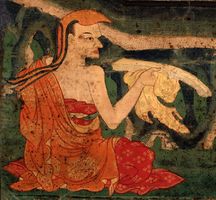Difference between revisions of "Sthiramati"
Jump to navigation
Jump to search
| Line 1: | Line 1: | ||
{{Person | {{Person | ||
| + | |HasDrlPage=Yes | ||
| + | |HasLibPage=Yes | ||
| + | |HasBnwPage=Yes | ||
|pagename=Sthiramati | |pagename=Sthiramati | ||
|PersonType=Classical Indian Authors | |PersonType=Classical Indian Authors | ||
|images=File:Sthiramati.jpg{{!}}[https://www.himalayanart.org/items/928 Himalayan Art Resources] | |images=File:Sthiramati.jpg{{!}}[https://www.himalayanart.org/items/928 Himalayan Art Resources] | ||
| − | |||
| − | |||
| − | |||
|MainNamePhon=Sthiramati | |MainNamePhon=Sthiramati | ||
|MainNameTib=བློ་གྲོས་བརྟན་པ་ | |MainNameTib=བློ་གྲོས་བརྟན་པ་ | ||
| Line 20: | Line 20: | ||
|DatesNotes=Dates from The Princeton Dictionary of Buddhism, 2014. | |DatesNotes=Dates from The Princeton Dictionary of Buddhism, 2014. | ||
|StudentOf=Vasubandhu; | |StudentOf=Vasubandhu; | ||
| − | |BnwShortPersonBio=Indian Buddhist philosopher associated particularly with [the] | + | |BnwShortPersonBio=Indian Buddhist philosopher associated particularly with [the] Yogācāra school. His dates are uncertain (leading one scholar to posit three figures with this name), but he is generally placed in the sixth century, although he is said to have been a disciple of both Vasubandhu and Guṇamati. Sthiramati seems to have been primarily based in Valabhī, but may have also studied at Nālandā. He wrote a number of important commentaries on such Yogācāra works as the ''Mahāyānasūtrālaṃkāra'' and ''Madhyāntavibhāga'' of Maitreyanātha and Vasubandhu’s ''Triṃśikā''. (Source: "Sthiramati." In ''The Princeton Dictionary of Buddhism'', 859. Princeton University Press, 2014. http://www.jstor.org/stable/j.ctt46n41q.27.) |
|IsInGyatsa=No | |IsInGyatsa=No | ||
}} | }} | ||
{{Footer}}<noinclude>{{DRL Authors of Sanskrit Works}} [[Category:Indian authors sanskrit names]]</noinclude> | {{Footer}}<noinclude>{{DRL Authors of Sanskrit Works}} [[Category:Indian authors sanskrit names]]</noinclude> | ||
Latest revision as of 15:49, 24 September 2020
བློ་གྲོས་བརྟན་པ་
| Wylie | blo gros brtan pa |
|---|---|
| Devanagari | स्थिरमति |
| Romanized Sanskrit | sthiramati |
| English Phonetics | Sthiramati |
| Chinese Transliteration | Anhui |
| Japanese Transliteration | An'e/Anne |
| Korean Transliteration | Anhye |
Other names
- སློབ་དཔོན་བློ་བརྟན་
- slob dpon blo brtan
Dates
| Birth: | 475 |
|---|---|
| Death: | 555 |
| Notes on dates: | Dates from The Princeton Dictionary of Buddhism, 2014. |
Tibetan calendar dates
About
- Teachers
- Vasubandhu
Other Biographical info:
Links
- Wiki Pages
Buddha Nature Project
- Person description or short bio
- Indian Buddhist philosopher associated particularly with [the] Yogācāra school. His dates are uncertain (leading one scholar to posit three figures with this name), but he is generally placed in the sixth century, although he is said to have been a disciple of both Vasubandhu and Guṇamati. Sthiramati seems to have been primarily based in Valabhī, but may have also studied at Nālandā. He wrote a number of important commentaries on such Yogācāra works as the Mahāyānasūtrālaṃkāra and Madhyāntavibhāga of Maitreyanātha and Vasubandhu’s Triṃśikā. (Source: "Sthiramati." In The Princeton Dictionary of Buddhism, 859. Princeton University Press, 2014. http://www.jstor.org/stable/j.ctt46n41q.27.)
Expand to see this person's philosophical positions on Buddha-nature.
| Is Buddha-nature considered definitive or provisional? | |
|---|---|
| Position: | |
| Notes: | |
| All beings have Buddha-nature | |
| Position: | |
| If "Qualified", explain: | |
| Notes: | |
| Which Wheel Turning | |
| Position: | |
| Notes: | |
| Yogācāra vs Madhyamaka | |
| Position: | |
| Notes: | |
| Zhentong vs Rangtong | |
| Position: | |
| Notes: | |
| Promotes how many vehicles? | |
| Position: | |
| Notes: | |
| Analytic vs Meditative Tradition | |
| Position: | |
| Notes: | |
| What is Buddha-nature? | |
| Position: | |
| Notes: | |
| Svātantrika (རང་རྒྱུད་) vs Prāsaṅgika (ཐལ་འགྱུར་པ་) | |
| Position: | |
| Notes: | |
| Causal nature of the vajrapāda | |
| Position: | |
